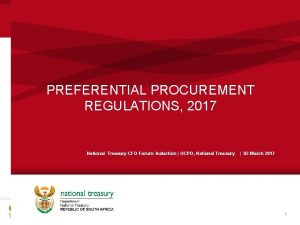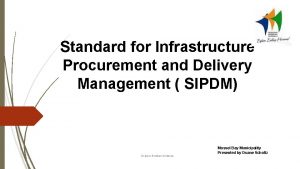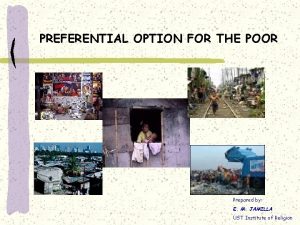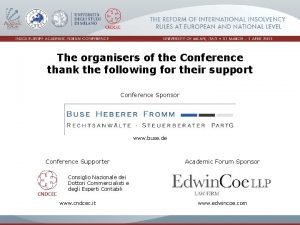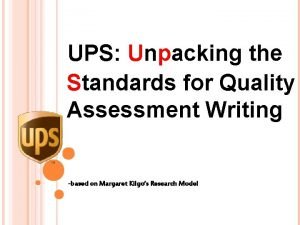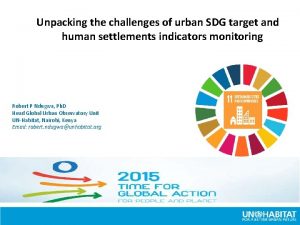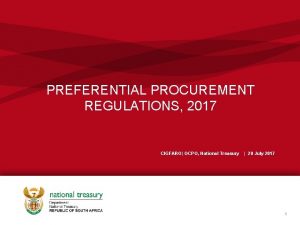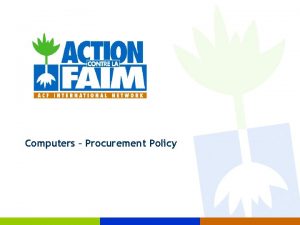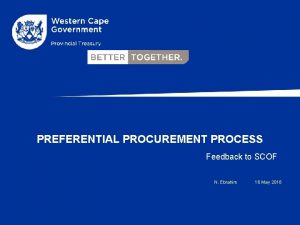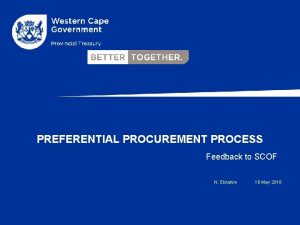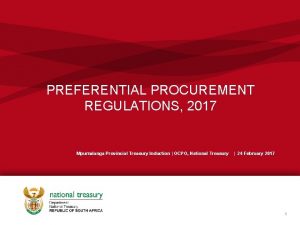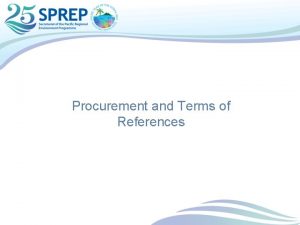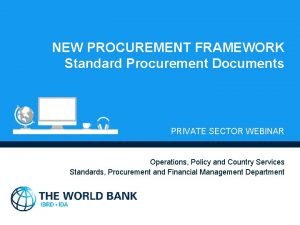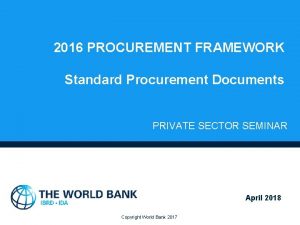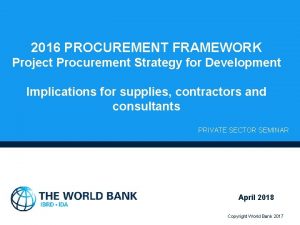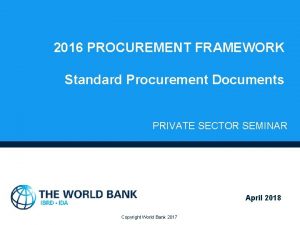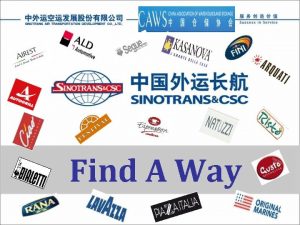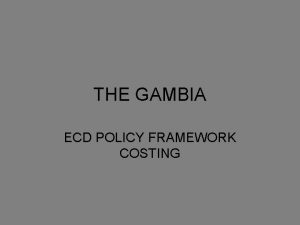CIGFARO PRESENTATION UNPACKING THE PREFERENTIAL PROCUREMENT POLICY FRAMEWORK






















- Slides: 22

CIGFARO PRESENTATION UNPACKING THE PREFERENTIAL PROCUREMENT POLICY FRAMEWORK ACT, REGULATIONS(2017): LOCAL SUPPLIERS, LOCAL CONTENT. PHILIA POTGIETER SCM ADVISOR

PURPOSE To focus on the alignment of the aims of the Preferential Procurement Policy Framework Act (PPPFA) and its revised Regulations of 2017 with the Broad Based Black Economic Empowerment Act (BBBEE) that makes provision for the promotion of locally produced goods, services and works.

The PPPFA and its Preferential Procurement Regulations of 2011 as revised in 2017 makes provision for the Department of Trade and Industry (dti), in consultation with National Treasury (NT), to designate a sector, subsector or industry or product in line with the national development plan and industrial policy's for local production and content. (Regulation 8). LEGISLATIVE ENVIRONMENT Only locally produced services or goods or locally manufactured goods that meet the minimum stipulated threshold for local production and content can be procured. NT informs all organs of state of new designations made i. t. o.

regulation 8 (1) through a circular/instruction note. LEGISLATIVE ENVIRONMENT The purpose of issuing a circular/instruction note is to regulate the environment within which Accounting Officers (AO) may procure products/services which has been designated.

With reference to the Preferential Procurement Regulations of 2017, regulation 8 for Local Production and Content, policy prescripts includes: Ø Regulation 8(2) compel organs of state, in the case of a designated sector, to advertise a tender with a specific condition that only locally produced goods or locally manufactured goods, meeting the stipulated minimum threshold for local production and content will be considered. Ø Regulation 8 (4) allows organs of state to “self designate” services or goods. This can only be done in conjunction with dti and NT. POLICIES

Ø POLICIES Regulation 8 (5) is clear , if a tenderer fails to meet the required minimum local content threshold it is an unacceptable tender and will not be evaluated further on points for price and B-BBEE status, except if dti approve exemption on request of a supplier. Ø AO are oblige to implement local content requirements for all designated products when advertising tenders, as per instruction notes/circulars.

Using public procurement strategically to leverage industrial development and support industrial policy’s. OBJECTIVES Stimulate and encourage the growth and development of local industries through the optimal usage of local resources and materials. Provide a instrument for increasing the purchase of domestic products.

INTRODUCTION: DEFINE LOCAL CONTENT The stipulated minimum threshold for local production and content can vary between 10 - 100%. Manufacturing is described as any kind of working or processing including assembly to specific operations. Material is described as ingredient, raw material, component or part used in the manufacturing of a product. Products is described as goods, services or works or manufactured goods as defined in the relevant National Legislation.

DEFENITION: DEFINE LOCAL CONTENT The local content of a product is the tender price less the value of imported content, expressed as a percentage. It is therefore, necessary to first compute the imported value of a product to determine the local content of a product. Ø To summarise, it is that portion of the tender price that is not included in the imported content, provided that local manufacturing takes place and is calculated in accordance with the local content formula. Ø Suppliers must differentiate between local and imported content.

DEFINE LOCAL CONTENT Imported content of a product by components/material/services is separated in two categories, e. g. : Ø Products imported directly by the supplier; and Ø Products imported by a third party and supplied to the supplier. Ø This information is necessary to complete annexure D –Import content declaration a supporting schedule to complete annexure C Local Content declaration summary schedule. Ø All commercial invoices, bills of entry must be kept on file that was used to calculate local content.

DEFINE LOCAL CONTENT Ø Types of services that can be importedproject management, design, testing, marketing, etc. Royalty and lease payments as applicable to be included when calculating imported content. Exempted imported content: -A supplier may request in writing from dti exemption if they cant comply with the prescribed local production and content requirements. The request must include the procuring entity, tender number, closing date, items requesting exemption for, reasons and supporting letters from local manufacturers and suppliers. Turn around time 5 -7 working days. Exemptions is not transferable to other tenders, its tender specific and the original letter to be appended to relevant tender.

LOCAL CONTENT MEASUREMENT. The local content percentage of a product shall be as specified in the tender document on SBD/MBD 6. 2 –Declaration for Local Production and content for designated sectors, paragraph 2. The description of services, works or goods and stipulate minimum threshold % is copied by the procuring organ of state from the relevant circular/instruction note. LC = ( 1 – x/y )*100 Ø LC Local Content Ø X is the imported content in RAND excluding VAT. Ø Y is the tender price in RAND excluding VAT.

APPLICATION IN THE PROCUREMENT PROCESSES. Advertisement of a tender of a designated sector: Ø NT has issued since 2012, 22 circulars/instruction notes to establish designated sectors. It can be down loaded from NT website. Ø In the case of a designated sector a tender will include a specific condition that only locally produced goods or locally manufactured goods, meeting the stipulated minimum threshold that’s indicated in paragraph 2 of SBD/MBD 6. 2 will be considered. Non compliance will be a unacceptable tender. Applicable tender documentation: Ø STB/MBD 6. 2 - Declaration certificate for designated sectors.

APPLICATION IN THE PROCUREMENT PROCESSES. Ø Paragraph 2 will be completed by the procuring authority, giving a description of services, works or goods and stipulated minimum threshold % that may not be changed by a supplier. Ø Sub-contracting may not be done in such a manner that the local production and content of the overall contract value is reduced below the stipulated minimum threshold. Ø Reference is made to SATS 1286: 2011 a technical specification issued by SABS to provide guidance to suppliers when calculating local content. It can be downloaded from dti website. Ø To determine X of the formula prices of products purchased in

APPLICATION IN THE PROCUREMENT PROCESSES. Ø Foreign currency must first be converted to rand using SARB exchange rate on the date of advertisement of the tender. The exchange rates is on SARB website and must be downloaded and a printout appended to SBD/MBD 6. 2. Ø Annexure C –Local content declaration, summary schedule MUST be completed , signed and appended to tender document. Ø Annexure D – Imported content declaration is supporting to annexure C and a copy can be submitted if requested. Ø Annexure E – Local content declaration supporting to schedule C and a copy can be submitted if requested.

APPLICATION IN THE PROCUREMENT PROCESSES. Ø If there is no imported content only annexure C and E will be completed. v Dti issued a guidance document for the calculation of local content and how to complete annexures C, D, E step by step. When a tender is awarded and local production and content is applicable the relevant procuring authority MUST without delay: Ø Inform dti. Ø Submit copy's of the tender document, SBD/MBD 6. 2 , SARB print out on exchange rate if applicable, Annexure C and if so required annexure D and E as applicable.

TO SUMMARISE THE COMPULSORY RETURNABLE TENDER DOCUMENTS AT CLOSING DATE AND TIME: APPLICATION IN THE PROCUREMENT PROCESSES. Suppliers must complete and sign SBD/MBD 6. 2 ; Provide calculations of local content percentages per item/s; Append the exchange rate on day of advertisement of tender as applicable; Append completed and signed Annexure C and if required D and E as applicable. Append original issued exemption letter/s for item/s that dti granted exemption for.

APPLICATION IN THE PROCUREMENT PROCESSES. Once the tender is awarded the relevant supplier MUST: Ø Keep copy’s of all documentation, invoices, calculations etc. for a period of 5 years. During this period DTI, SABS, SANAS OR IRBA or any other verification agency appointed by dti may do a inspection to verify calculations and information as reflected on annexures C, D, E. EVALUATION OF TENDERS: Ø Two stage process. Ø First pre-qualification criteria is compliance with local content requirements. Ø Tenders who do not meet the stipulated minimum threshold values and do not have exemption from dti is a unacceptable tender and will be eliminated.

Non compliance with the submission of completed and signed prescribed documents is unacceptable tenders. APPLICATION IN THE PROCUREMENT PROCESSES. Only compliant tenders will go to the second stage for evaluation on points for price and B-BBEEE points. If all tenders is non compliant the tender will be cancelled, dti informed to assist to investigate the reasons for non-compliance and provide guidance.

Dti provide in all circulars/instruction notes a reference person per commodity/product/service that will assist suppliers and organs of state and give guidance on how to approach the market. Suppliers can request a list of possible manufacturers that they can approach to source goods/services from. SUPPLIER SUPPORT. SATS 1286: 2011 technical specification can be down loaded to assist with calculation of local content. Dti guideline on calculation of local content and completion of annexure C, D, E is a step by step guide to complete the relevant annexures.

More sectors will be designated according to the Minister of Finance pronouncement to stimulate economic growth. Designated sectors will become a major part of governments procurement strategy going forward. CONCLUSION. Local suppliers need to position themselves and engage with relevant wholesalers and manufacturers who can supply products that complies with the demand to ensure beneficiation. THANK YOU

 Preferential procurement regulations 2017
Preferential procurement regulations 2017 Cigfaro membership
Cigfaro membership Cigfaro membership
Cigfaro membership Sipdm gate review framework
Sipdm gate review framework Preferential looking test
Preferential looking test Preferential option for the poor
Preferential option for the poor Heti rpr
Heti rpr Preferential
Preferential What is preferential allotment
What is preferential allotment Floating charge
Floating charge Gender preferential speech features
Gender preferential speech features Strengths and weaknesses of pacifism
Strengths and weaknesses of pacifism Unpacking the prompt
Unpacking the prompt Common core state standards pa
Common core state standards pa 5ps of unpacking competencies
5ps of unpacking competencies Unpack common core
Unpack common core Gif unpacking in census
Gif unpacking in census Pracshack
Pracshack Unpacking the teks
Unpacking the teks Unpacking the teks
Unpacking the teks Charada
Charada Give 5 personal characteristics required by a valet
Give 5 personal characteristics required by a valet Unpacking the prompt
Unpacking the prompt
